Perinatal or adult Nf1 inactivation using tamoxifen-inducible PlpCre each cause neurofibroma formation
- PMID: 21551249
- PMCID: PMC3464476
- DOI: 10.1158/0008-5472.CAN-10-4558
Perinatal or adult Nf1 inactivation using tamoxifen-inducible PlpCre each cause neurofibroma formation
Abstract
Plexiform neurofibromas are peripheral nerve sheath tumors initiated by biallelic mutation of the NF1 tumor suppressor gene in the Schwann cell lineage. To understand whether neurofibroma formation is possible after birth, we induced Nf1 loss of function with an inducible proteolipid protein Cre allele. Perinatal loss of Nf1 resulted in the development of small plexiform neurofibromas late in life, whereas loss in adulthood caused large plexiform neurofibromas and morbidity beginning 4 months after onset of Nf1 loss. A conditional EGFP reporter allele identified cells showing recombination, including peripheral ganglia satellite cells, peripheral nerve S100β+ myelinating Schwann cells, and peripheral nerve p75+ cells. Neurofibromas contained cells with Remak bundle disruption but no recombination within GFAP+ nonmyelinating Schwann cells. Extramedullary lympho-hematopoietic expansion was also observed in PlpCre;Nf1fl/fl mice. These tumors contained EGFP+/Sca-1+ stromal cells among EGFP-negative lympho-hematopoietic cells indicating a noncell autonomous effect and unveiling a role of Nf1-deleted microenvironment on lympho-hematopoietic proliferation in vivo. Together these findings define a tumor suppressor role for Nf1 in the adult and narrow the range of potential neurofibroma-initiating cell populations.
©2011 AACR.
Figures

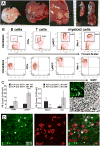
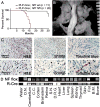
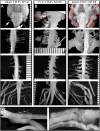

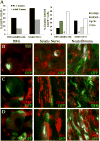
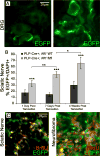
Similar articles
-
Susceptible stages in Schwann cells for NF1-associated plexiform neurofibroma development.Cancer Res. 2011 Jul 1;71(13):4686-95. doi: 10.1158/0008-5472.CAN-10-4577. Epub 2011 May 6. Cancer Res. 2011. PMID: 21551250 Free PMC article.
-
Cdkn2a Loss in a Model of Neurofibroma Demonstrates Stepwise Tumor Progression to Atypical Neurofibroma and MPNST.Cancer Res. 2020 Nov 1;80(21):4720-4730. doi: 10.1158/0008-5472.CAN-19-1429. Epub 2020 Aug 19. Cancer Res. 2020. PMID: 32816910 Free PMC article.
-
Chromosome 17 loss-of-heterozygosity studies in benign and malignant tumors in neurofibromatosis type 1.Genes Chromosomes Cancer. 2000 Aug;28(4):425-31. Genes Chromosomes Cancer. 2000. PMID: 10862051
-
Tumor suppressor mutations and growth factor signaling in the pathogenesis of NF1-associated peripheral nerve sheath tumors. I. The role of tumor suppressor mutations.J Neuropathol Exp Neurol. 2004 Nov;63(11):1115-23. doi: 10.1093/jnen/63.11.1115. J Neuropathol Exp Neurol. 2004. PMID: 15581179 Review.
-
Tumor microenvironment and neurofibromatosis type I: connecting the GAPs.Oncogene. 2007 Jul 12;26(32):4609-16. doi: 10.1038/sj.onc.1210261. Epub 2007 Feb 12. Oncogene. 2007. PMID: 17297459 Free PMC article. Review.
Cited by
-
A molecular basis for neurofibroma-associated skeletal manifestations in NF1.Genet Med. 2020 Nov;22(11):1786-1793. doi: 10.1038/s41436-020-0885-3. Epub 2020 Jun 30. Genet Med. 2020. PMID: 32601387 Free PMC article.
-
Schwann cell derived pleiotrophin stimulates fibroblast for proliferation and excessive collagen deposition in plexiform neurofibroma.Cancer Gene Ther. 2024 Apr;31(4):627-640. doi: 10.1038/s41417-024-00727-1. Epub 2024 Feb 2. Cancer Gene Ther. 2024. PMID: 38302728
-
Genetic predisposition to peripheral nerve neoplasia: diagnostic criteria and pathogenesis of neurofibromatoses, Carney complex, and related syndromes.Acta Neuropathol. 2012 Mar;123(3):349-67. doi: 10.1007/s00401-011-0935-7. Epub 2011 Dec 31. Acta Neuropathol. 2012. PMID: 22210082 Free PMC article. Review.
-
Neurofibroma Development in Neurofibromatosis Type 1: Insights from Cellular Origin and Schwann Cell Lineage Development.Cancers (Basel). 2022 Sep 17;14(18):4513. doi: 10.3390/cancers14184513. Cancers (Basel). 2022. PMID: 36139671 Free PMC article. Review.
-
Preclinical therapeutic efficacy of a novel pharmacologic inducer of apoptosis in malignant peripheral nerve sheath tumors.Cancer Res. 2014 Jan 15;74(2):586-97. doi: 10.1158/0008-5472.CAN-13-1934. Epub 2013 Nov 27. Cancer Res. 2014. PMID: 24285727 Free PMC article.
References
-
- Friedman JM. Epidemiology of neurofibromatosis type 1. Am J Med Genet. 1999;891:1–6. - PubMed
-
- Rosenfeld A, Listernick R, Charrow J, Goldman S. Neurofibromatosis type 1 and high-grade tumors of the central nervous system. Childs Nerv Syst. 2010;265:663–7. - PubMed
-
- Emanuel PD, Bates LJ, Castleberry RP, et al. Selective hypersensitivity to granulocyte-macrophage colony-stimulating factor by juvenile chronic myeloid leukemia hematopoietic progenitors. Blood. 1991;77:925–929. - PubMed
-
- Niemeyer CM, Arico M, Basso G, et al. Quantitative effects of Nf1 inactivation on in vivo hematopoiesis. Blood. 1997;89:3534. - PubMed
Publication types
MeSH terms
Substances
Grants and funding
LinkOut - more resources
Full Text Sources
Molecular Biology Databases
Research Materials
Miscellaneous

